Target Information
| Target General Information | Top | |||||
|---|---|---|---|---|---|---|
| Target ID |
T31204
(Former ID: TTDS00104)
|
|||||
| Target Name |
5-HT 2B receptor (HTR2B)
|
|||||
| Synonyms |
Serotonin receptor 2B; 5-hydroxytryptamine receptor 2B; 5-HT2B; 5-HT-2B; 5-HT 2B
Click to Show/Hide
|
|||||
| Gene Name |
HTR2B
|
|||||
| Target Type |
Successful target
|
[1] | ||||
| Disease | [+] 4 Target-related Diseases | + | ||||
| 1 | Depression [ICD-11: 6A70-6A7Z] | |||||
| 2 | Pituitary gland disorder [ICD-11: 5A60-5A61] | |||||
| 3 | Psychotic disorder [ICD-11: 6A20-6A25] | |||||
| 4 | Attention deficit hyperactivity disorder [ICD-11: 6A05] | |||||
| Function |
Functions as a receptor for various ergot alkaloid derivatives and psychoactive substances. Ligand binding causes a conformation change that triggers signaling via guanine nucleotide-binding proteins (G proteins) and modulates the activity of down-stream effectors. Beta-arrestin family members inhibit signaling via G proteins and mediate activation of alternative signaling pathways. Signaling activates a phosphatidylinositol-calcium second messenger system that modulates the activity of phosphatidylinositol 3-kinase and down-stream signaling cascades and promotes the release of Ca(2+) ions from intracellular stores. Plays a role in the regulation of dopamine and 5-hydroxytryptamine release, 5-hydroxytryptamine uptake and in the regulation of extracellular dopamine and 5-hydroxytryptamine levels, and thereby affects neural activity. May play a role in the perception of pain. Plays a role in the regulation of behavior, including impulsive behavior. Required for normal proliferation of embryonic cardiac myocytes and normal heart development. Protects cardiomyocytes against apoptosis. Plays a role in the adaptation of pulmonary arteries to chronic hypoxia. Plays a role in vasoconstriction. Required for normal osteoblast function and proliferation, and for maintaining normal bone density. Required for normal proliferation of the interstitial cells of Cajal in the intestine. G-protein coupled receptor for 5-hydroxytryptamine (serotonin).
Click to Show/Hide
|
|||||
| BioChemical Class |
GPCR rhodopsin
|
|||||
| UniProt ID | ||||||
| Sequence |
MALSYRVSELQSTIPEHILQSTFVHVISSNWSGLQTESIPEEMKQIVEEQGNKLHWAALL
ILMVIIPTIGGNTLVILAVSLEKKLQYATNYFLMSLAVADLLVGLFVMPIALLTIMFEAM WPLPLVLCPAWLFLDVLFSTASIMHLCAISVDRYIAIKKPIQANQYNSRATAFIKITVVW LISIGIAIPVPIKGIETDVDNPNNITCVLTKERFGDFMLFGSLAAFFTPLAIMIVTYFLT IHALQKKAYLVKNKPPQRLTWLTVSTVFQRDETPCSSPEKVAMLDGSRKDKALPNSGDET LMRRTSTIGKKSVQTISNEQRASKVLGIVFFLFLLMWCPFFITNITLVLCDSCNQTTLQM LLEIFVWIGYVSSGVNPLVYTLFNKTFRDAFGRYITCNYRATKSVKTLRKRSSKIYFRNP MAENSKFFKKHGIRNGINPAMYQSPMRLRSSTIQSSSIILLDTLLLTENEGDKTEEQVSY V Click to Show/Hide
|
|||||
| 3D Structure | Click to Show 3D Structure of This Target | AlphaFold | ||||
| ADReCS ID | BADD_A00273 ; BADD_A02979 ; BADD_A04075 | |||||
| HIT2.0 ID | T78BSU | |||||
| Drugs and Modes of Action | Top | |||||
|---|---|---|---|---|---|---|
| Approved Drug(s) | [+] 4 Approved Drugs | + | ||||
| 1 | Metergolin | Drug Info | Approved | Hyperprolactinaemia | [2] | |
| 2 | Minaprine | Drug Info | Approved | Depression | [2], [3] | |
| 3 | Triflupromazine | Drug Info | Approved | Psychotic disorder | [4], [5] | |
| 4 | SPN-812 | Drug Info | Phase 4 | Attention deficit hyperactivity disorder | [6] | |
| Clinical Trial Drug(s) | [+] 2 Clinical Trial Drugs | + | ||||
| 1 | PRX-08066 | Drug Info | Phase 2 | Pulmonary arterial hypertension | [7] | |
| 2 | Vabicaserin | Drug Info | Phase 2 | Psychotic disorder | [8] | |
| Discontinued Drug(s) | [+] 3 Discontinued Drugs | + | ||||
| 1 | FENDILINE | Drug Info | Withdrawn from market | Coronary artery disease | [9] | |
| 2 | Ritanserin | Drug Info | Discontinued in Phase 3 | Anxiety disorder | [10], [11] | |
| 3 | MT-500 | Drug Info | Discontinued in Phase 1 | Migraine | [12] | |
| Mode of Action | [+] 4 Modes of Action | + | ||||
| Antagonist | [+] 34 Antagonist drugs | + | ||||
| 1 | Metergolin | Drug Info | [13] | |||
| 2 | Minaprine | Drug Info | [14], [15] | |||
| 3 | Triflupromazine | Drug Info | [1] | |||
| 4 | SPN-812 | Drug Info | [16] | |||
| 5 | PRX-08066 | Drug Info | [7] | |||
| 6 | Pyrazole-3-carboxamide derivative 1 | Drug Info | [19] | |||
| 7 | Pyrimidine derivative 23 | Drug Info | [19] | |||
| 8 | Pyrimidine derivative 24 | Drug Info | [19] | |||
| 9 | Pyrimidine derivative 25 | Drug Info | [19] | |||
| 10 | Pyrimidine derivative 26 | Drug Info | [19] | |||
| 11 | Pyrimidine derivative 27 | Drug Info | [19] | |||
| 12 | Pyrimidine derivative 28 | Drug Info | [19] | |||
| 13 | Pyrimidine derivative 29 | Drug Info | [19] | |||
| 14 | Quinoline derivative 2 | Drug Info | [19] | |||
| 15 | Ritanserin | Drug Info | [21] | |||
| 16 | MT-500 | Drug Info | [2] | |||
| 17 | LY53857 | Drug Info | [21] | |||
| 18 | SB 206553 | Drug Info | [23] | |||
| 19 | 1-naphthylpiperazine | Drug Info | [29] | |||
| 20 | EGIS-7625 | Drug Info | [40] | |||
| 21 | LY86057 | Drug Info | [29] | |||
| 22 | norfluoxetine | Drug Info | [24] | |||
| 23 | piribedil | Drug Info | [42] | |||
| 24 | R-1 | Drug Info | [43] | |||
| 25 | RQ-00310941 | Drug Info | [43] | |||
| 26 | SB 204741 | Drug Info | [13] | |||
| 27 | SB 215505 | Drug Info | [44] | |||
| 28 | SB 221284 | Drug Info | [13] | |||
| 29 | SB 228357 | Drug Info | [45] | |||
| 30 | SB 242084 | Drug Info | [46] | |||
| 31 | spiramide | Drug Info | [13] | |||
| 32 | spiroxatrine | Drug Info | [47] | |||
| 33 | [3H]mesulergine | Drug Info | [13] | |||
| 34 | [3H]rauwolscine | Drug Info | [47] | |||
| Modulator | [+] 1 Modulator drugs | + | ||||
| 1 | Vabicaserin | Drug Info | [17], [18] | |||
| Inhibitor | [+] 42 Inhibitor drugs | + | ||||
| 1 | FENDILINE | Drug Info | [20] | |||
| 2 | Ro-60-0175 | Drug Info | [22] | |||
| 3 | (+/-)-nantenine | Drug Info | [25] | |||
| 4 | (2S)-1-(6-methoxy-1H-indazol-1-yl)propan-2-amine | Drug Info | [26] | |||
| 5 | (5-methoxy-1H-indol-3-yl)methanamine | Drug Info | [20] | |||
| 6 | 1-((R)-2-aminopropyl)-1H-indazol-6-ol | Drug Info | [26] | |||
| 7 | 1-((S)-2-aminopropyl)-1H-indazol-6-ol | Drug Info | [26] | |||
| 8 | 1-((S)-2-aminopropyl)-7-chloro-1H-indazol-6-ol | Drug Info | [26] | |||
| 9 | 1-((S)-2-aminopropyl)-7-fluoro-1H-indazol-6-ol | Drug Info | [26] | |||
| 10 | 1-((S)-2-aminopropyl)-7-iodo-1H-indazol-6-ol | Drug Info | [26] | |||
| 11 | 1-((S)-2-aminopropyl)-7-methyl-1H-indazol-6-ol | Drug Info | [26] | |||
| 12 | 1-(2-aminoethyl)-1H-indazol-6-ol | Drug Info | [26] | |||
| 13 | 1-(3-(pentafluorosulfanyl)phenyl)propan-2-amine | Drug Info | [27] | |||
| 14 | 1-Butyl-3-(2-dimethylamino-ethyl)-1H-indol-4-ol | Drug Info | [28] | |||
| 15 | 2-(5-Methoxy-1H-indol-3-yl)-1-methyl-ethylamine | Drug Info | [26] | |||
| 16 | 3-(2-Amino-propyl)-1H-indol-5-ol | Drug Info | [26] | |||
| 17 | 3-(2-Dimethylamino-ethyl)-1-methyl-1H-indol-4-ol | Drug Info | [28] | |||
| 18 | 3-(2-Dimethylamino-ethyl)-1H-indol-6-ol | Drug Info | [28] | |||
| 19 | 3-(2-Dimethylamino-propyl)-1H-indol-4-ol | Drug Info | [28] | |||
| 20 | 3-(2-Pyrrolidin-1-yl-ethyl)-1H-indol-4-ol | Drug Info | [28] | |||
| 21 | 3-(3-Dimethylamino-propyl)-1H-indol-4-ol | Drug Info | [28] | |||
| 22 | 3-Dimethylaminomethyl-1-methyl-1H-indol-4-ol | Drug Info | [28] | |||
| 23 | 3-Dimethylaminomethyl-1H-indol-4-ol | Drug Info | [28] | |||
| 24 | 4-(4-butylpiperidin-1-yl)-1-o-tolylbutan-1-one | Drug Info | [30] | |||
| 25 | 5-MEO-DMT | Drug Info | [26] | |||
| 26 | 6,7-dichloro-2,3,4,5-tetrahydro-1H-3-benzazepine | Drug Info | [31] | |||
| 27 | 6-Fluoromelatonin | Drug Info | [20] | |||
| 28 | 7,8,9,10-tetrahydro-6H-furo-[2,3-g][3]benzazepine | Drug Info | [31] | |||
| 29 | 7,8,9,10-tetrahydro-6H-furo-[3,2-g][3]benzazepine | Drug Info | [31] | |||
| 30 | A-987306 | Drug Info | [32] | |||
| 31 | ADRENOGLOMERULOTROPIN | Drug Info | [20] | |||
| 32 | ADS-103253 | Drug Info | [33] | |||
| 33 | ADS-103274 | Drug Info | [33] | |||
| 34 | CHLOROPHENYLPIPERAZINE | Drug Info | [38] | |||
| 35 | Racemic DOI | Drug Info | [32] | |||
| 36 | SEROTONIN | Drug Info | [22] | |||
| 37 | VER-2692 | Drug Info | [22] | |||
| 38 | VER-3323 | Drug Info | [48] | |||
| 39 | VER-5384 | Drug Info | [48] | |||
| 40 | VER-5593 | Drug Info | [48] | |||
| 41 | YM-348 | Drug Info | [31] | |||
| 42 | [2-(4-Fluoro-1H-indol-3-yl)-ethyl]-dimethyl-amine | Drug Info | [28] | |||
| Agonist | [+] 18 Agonist drugs | + | ||||
| 1 | (+)-norfenfluramine | Drug Info | [24] | |||
| 2 | (-)-norfenfluramine | Drug Info | [24] | |||
| 3 | 2-methyl-5-HT | Drug Info | [29] | |||
| 4 | 5-CT | Drug Info | [29] | |||
| 5 | AL-37350A | Drug Info | [34] | |||
| 6 | alpha-methyl-5-HT | Drug Info | [35] | |||
| 7 | BRL-15572 | Drug Info | [36] | |||
| 8 | BW723C86 | Drug Info | [37] | |||
| 9 | dihydroergocryptine | Drug Info | [39] | |||
| 10 | m-chlorophenylpiperazine | Drug Info | [29] | |||
| 11 | METHYLENEDIOXYMETHAMPHETAMINE | Drug Info | [41] | |||
| 12 | norfenfluramine | Drug Info | [24] | |||
| 13 | Org 12962 | Drug Info | [13] | |||
| 14 | SB 216641 | Drug Info | [36] | |||
| 15 | TFMPP | Drug Info | [29] | |||
| 16 | [125I]DOI | Drug Info | [43] | |||
| 17 | [3H]5-HT | Drug Info | [29] | |||
| 18 | [3H]LSD | Drug Info | [49] | |||
| Cell-based Target Expression Variations | Top | |||||
|---|---|---|---|---|---|---|
| Cell-based Target Expression Variations | ||||||
| Drug Binding Sites of Target | Top | |||||
|---|---|---|---|---|---|---|
| Ligand Name: Ergotamine | Ligand Info | |||||
| Structure Description | Crystal structure of the chimeric protein of 5-HT2B-BRIL in complex with ergotamine | PDB:4IB4 | ||||
| Method | X-ray diffraction | Resolution | 2.70 Å | Mutation | Yes | [39] |
| PDB Sequence |
EEQGNKLHWA
57 ALLILMVIIP67 TIGGNTLVIL77 AVSLEKKLQY87 ATNYFLMSLA97 VADLLVGLFV 107 MPIALLTIMF117 EAMWPLPLVL127 CPAWLFLDVL137 FSTASIWHLC147 AISVDRYIAI 157 KKPIQANQYN167 SRATAFIKIT177 VVWLISIGIA187 IPVPIKGIET197 NPNNITCVLT 210 KERFGDFMLF220 GSLAAFFTPL230 AIMIVTYFLT240 IHALQKKAAD1002 LEDNWETLND 1012 NLKVIEKADN1022 AAQVKDALTK1032 MRAAALDAQK1042 KDFRHGFDIL1068 VGQIDDALKL 1078 ANEGKVKEAQ1088 AAAEQLKTTR1098 NAYIQKYLQT315 ISNEQRASKV325 LGIVFFLFLL 335 MWCPFFITNI345 TLVLCDSCNQ355 TTLQMLLEIF365 VWIGYVSSGV375 NPLVYTLFNK 385 TFRDAFGRYI395 TCNYR
|
|||||
|
|
TRP131
4.190
LEU132
3.774
ASP135
2.630
VAL136
3.633
SER139
3.431
THR140
2.954
ILE186
4.733
CYS207
3.903
VAL208
3.580
LEU209
2.879
THR210
3.670
LYS211
3.659
PHE214
4.836
GLY215
4.879
PHE217
3.838
|
|||||
| Click to View More Binding Site Information of This Target and Ligand Pair | ||||||
| Ligand Name: Methylergonovine | Ligand Info | |||||
| Structure Description | Structural Determinants of Activation and Biased Agonism at the 5-HT2B Receptor | PDB:6DRY | ||||
| Method | X-ray diffraction | Resolution | 2.92 Å | Mutation | Yes | [50] |
| PDB Sequence |
MKQIVEEQGN
52 KLHWAALLIL62 MVIIPTIGGN72 TLVILAVSLE82 KKLQYATNYF92 LMSLAVADLL 102 VGLFVMPIAL112 LTIMFEAMWP122 LPLVLCPAWL132 FLDVLFSTAS142 IWHLCAISVD 152 RYIAIKKPIQ162 ANNSRATAFI174 KITVVWLISI184 GIAIPVPIKG194 IETDNPNNIT 206 CVLTKERFGD216 FMLFGSLAAF226 FTPLAIMIVT236 YFLTIHALQK246 KAADLEDNWE 1008 TLNDNLKVIE1018 KADNAAQVKD1028 ALTKMRAAAL1038 DAQKATPPKL1048 EPEMKDFRHG 1064 FDILVGQIDD1074 ALKLANEGKV1084 KEAQAAAEQL1094 KTTRNAYIQK1104 YLVQTISNEQ 320 RASKVLGIVF330 FLFLLMWCPF340 FITNITLVLC350 DSCNQTTLQM360 LLEIFVWIGY 370 VSSGVNPLVY380 TLFNKTFRDA390 FGRYITCNYR400
|
|||||
|
|
LEU132
4.626
ASP135
2.531
VAL136
3.720
SER139
3.824
THR140
3.319
ILE186
4.919
CYS207
4.087
VAL208
3.298
LEU209
2.739
PHE217
3.605
MET218
4.527
GLY221
3.517
|
|||||
| Click to View More Binding Site Information of This Target with Different Ligands | ||||||
| Different Human System Profiles of Target | Top |
|---|---|
|
Human Similarity Proteins
of target is determined by comparing the sequence similarity of all human proteins with the target based on BLAST. The similarity proteins for a target are defined as the proteins with E-value < 0.005 and outside the protein families of the target.
A target that has fewer human similarity proteins outside its family is commonly regarded to possess a greater capacity to avoid undesired interactions and thus increase the possibility of finding successful drugs
(Brief Bioinform, 21: 649-662, 2020).
Human Pathway Affiliation
of target is determined by the life-essential pathways provided on KEGG database. The target-affiliated pathways were defined based on the following two criteria (a) the pathways of the studied target should be life-essential for both healthy individuals and patients, and (b) the studied target should occupy an upstream position in the pathways and therefore had the ability to regulate biological function.
Targets involved in a fewer pathways have greater likelihood to be successfully developed, while those associated with more human pathways increase the chance of undesirable interferences with other human processes
(Pharmacol Rev, 58: 259-279, 2006).
Human Similarity Proteins
Human Pathway Affiliation
|
|
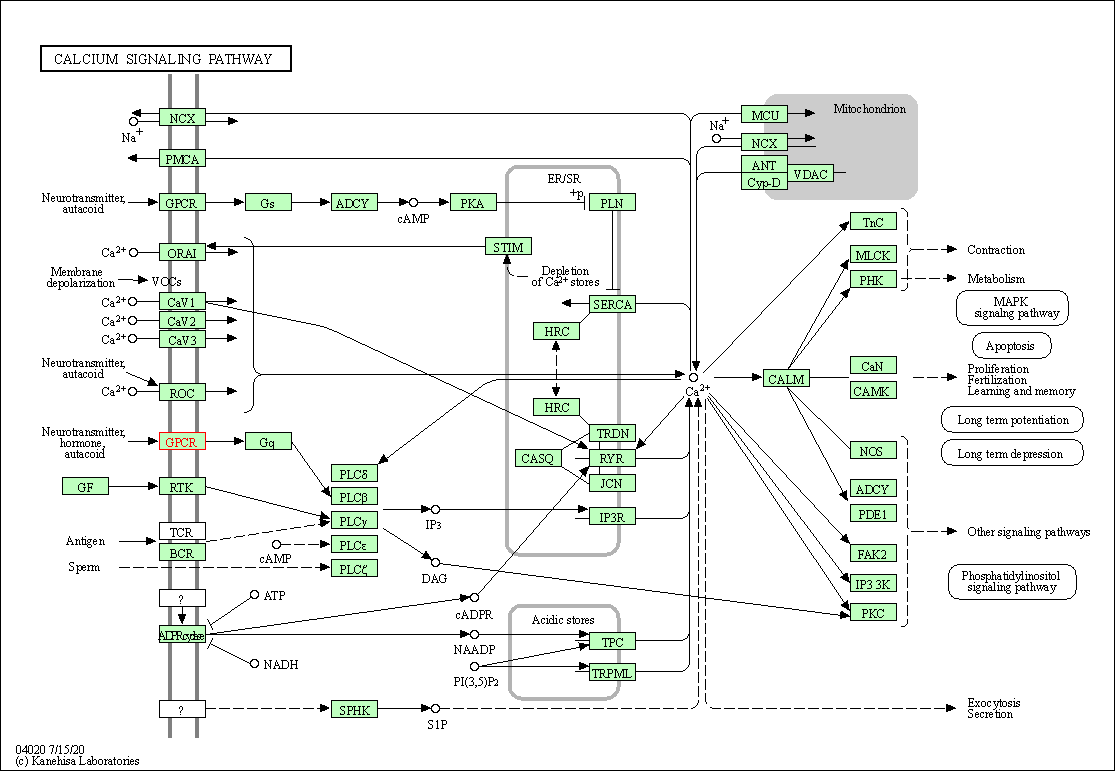
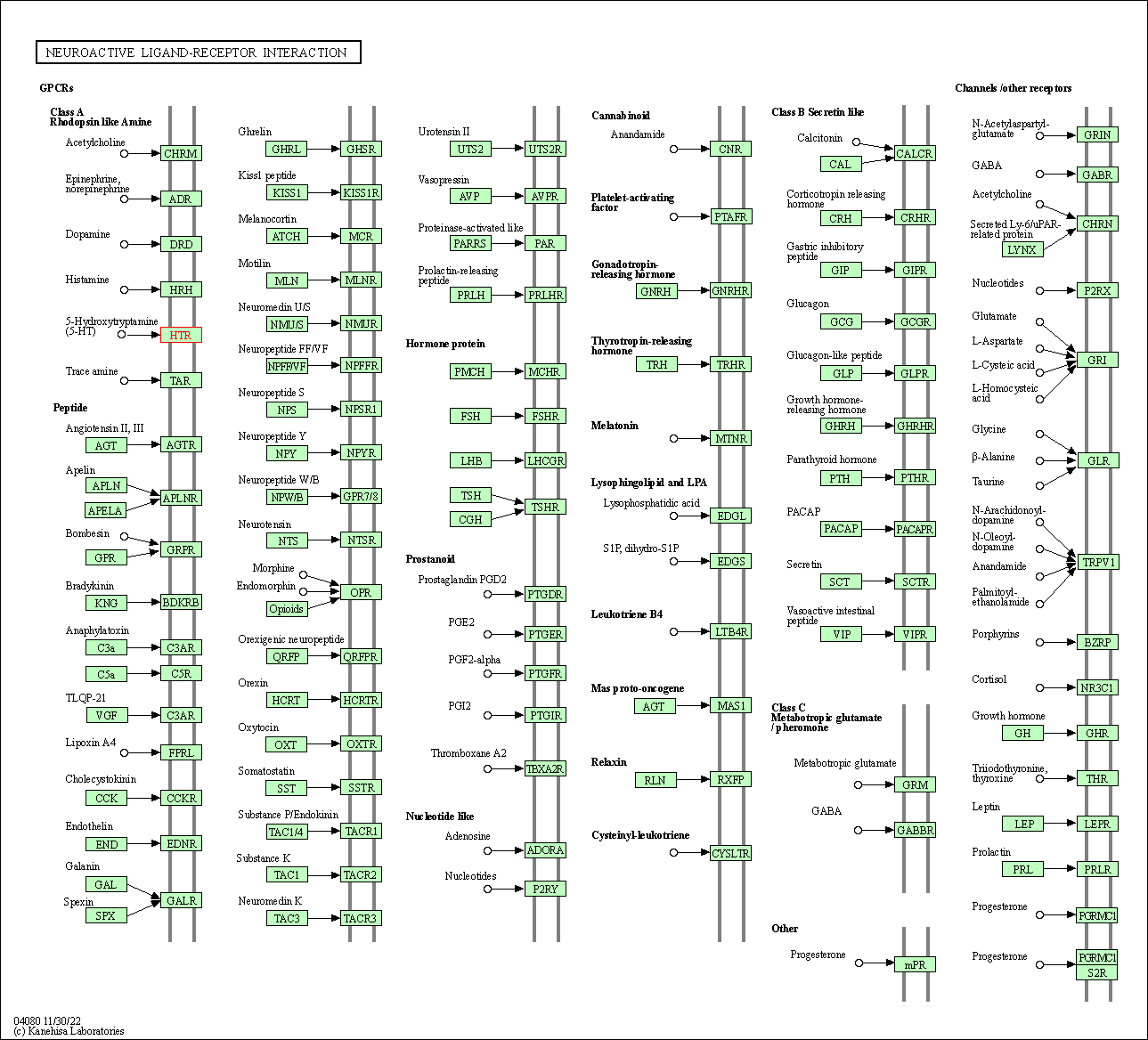
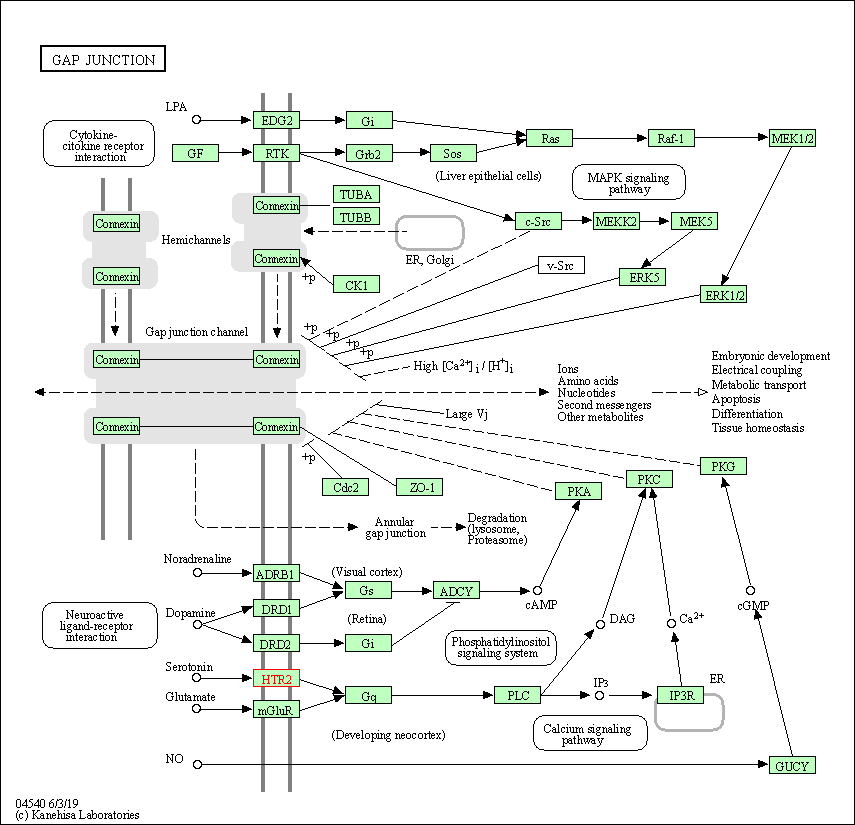
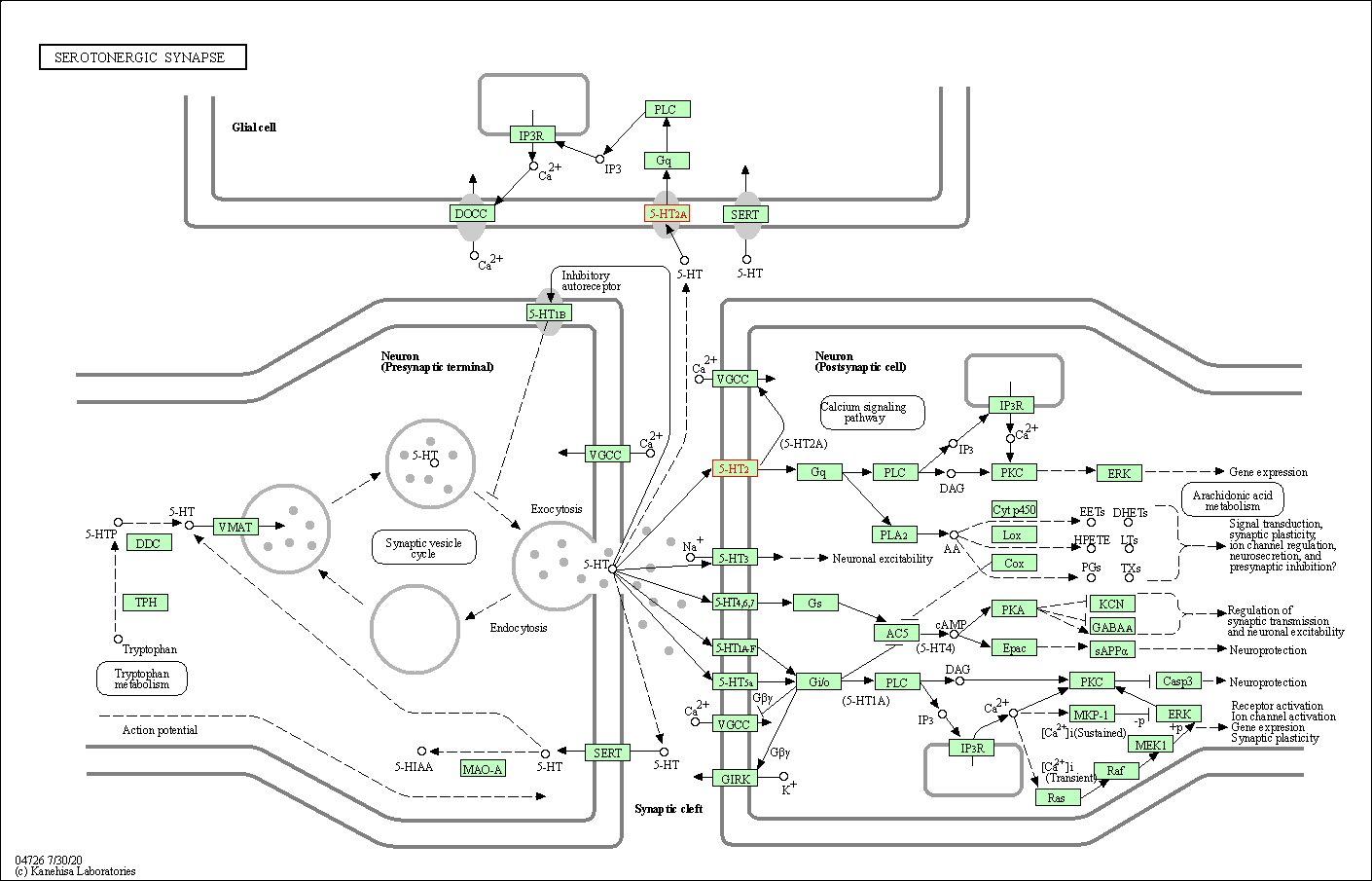
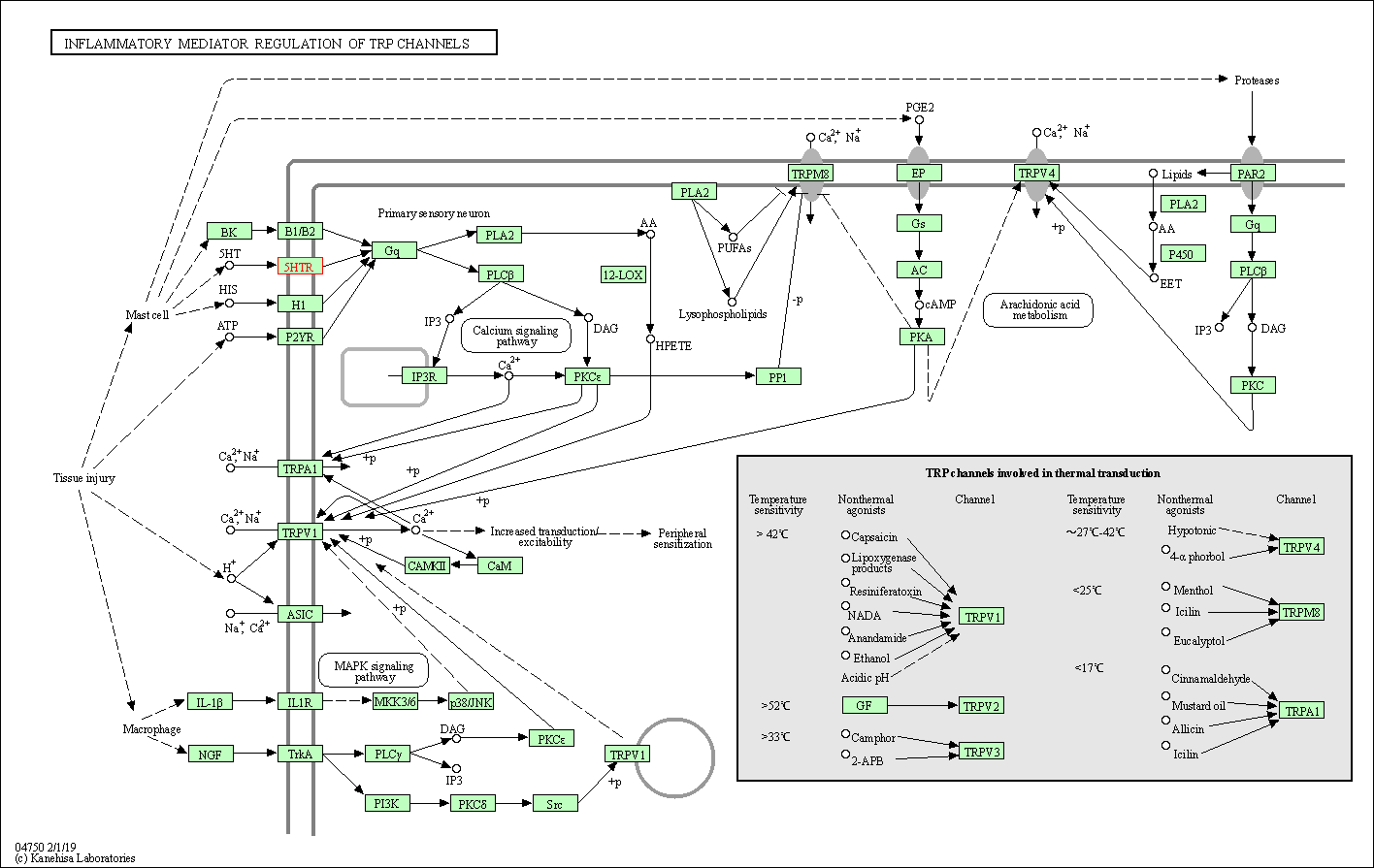
| KEGG Pathway | Pathway ID | Affiliated Target | Pathway Map |
|---|---|---|---|
| Calcium signaling pathway | hsa04020 | Affiliated Target |

|
| Class: Environmental Information Processing => Signal transduction | Pathway Hierarchy | ||
| Neuroactive ligand-receptor interaction | hsa04080 | Affiliated Target |

|
| Class: Environmental Information Processing => Signaling molecules and interaction | Pathway Hierarchy | ||
| Gap junction | hsa04540 | Affiliated Target |

|
| Class: Cellular Processes => Cellular community - eukaryotes | Pathway Hierarchy | ||
| Serotonergic synapse | hsa04726 | Affiliated Target |

|
| Class: Organismal Systems => Nervous system | Pathway Hierarchy | ||
| Inflammatory mediator regulation of TRP channels | hsa04750 | Affiliated Target |

|
| Class: Organismal Systems => Sensory system | Pathway Hierarchy | ||
| Chemical Structure based Activity Landscape of Target | Top |
|---|---|
| Drug Property Profile of Target | Top | |
|---|---|---|
| (1) Molecular Weight (mw) based Drug Clustering | (2) Octanol/Water Partition Coefficient (xlogp) based Drug Clustering | |
|
|
||
| (3) Hydrogen Bond Donor Count (hbonddonor) based Drug Clustering | (4) Hydrogen Bond Acceptor Count (hbondacc) based Drug Clustering | |
|
|
||
| (5) Rotatable Bond Count (rotbonds) based Drug Clustering | (6) Topological Polar Surface Area (polararea) based Drug Clustering | |
|
|
||
| "RO5" indicates the cutoff set by lipinski's rule of five; "D123AB" colored in GREEN denotes the no violation of any cutoff in lipinski's rule of five; "D123AB" colored in PURPLE refers to the violation of only one cutoff in lipinski's rule of five; "D123AB" colored in BLACK represents the violation of more than one cutoffs in lipinski's rule of five | ||
| Co-Targets | Top | |||||
|---|---|---|---|---|---|---|
| Co-Targets | ||||||
| Target Poor or Non Binders | Top | |||||
|---|---|---|---|---|---|---|
| Target Poor or Non Binders | ||||||
| Target Profiles in Patients | Top | |||||
|---|---|---|---|---|---|---|
| Target Expression Profile (TEP) |
||||||
| Target Affiliated Biological Pathways | Top | |||||
|---|---|---|---|---|---|---|
| KEGG Pathway | [+] 5 KEGG Pathways | + | ||||
| 1 | Calcium signaling pathway | |||||
| 2 | Neuroactive ligand-receptor interaction | |||||
| 3 | Gap junction | |||||
| 4 | Serotonergic synapse | |||||
| 5 | Inflammatory mediator regulation of TRP channels | |||||
| Panther Pathway | [+] 1 Panther Pathways | + | ||||
| 1 | 5HT2 type receptor mediated signaling pathway | |||||
| Reactome | [+] 2 Reactome Pathways | + | ||||
| 1 | Serotonin receptors | |||||
| 2 | G alpha (q) signalling events | |||||
| WikiPathways | [+] 6 WikiPathways | + | ||||
| 1 | Serotonin Receptor 2 and ELK-SRF/GATA4 signaling | |||||
| 2 | Monoamine GPCRs | |||||
| 3 | GPCRs, Class A Rhodopsin-like | |||||
| 4 | Gastrin-CREB signalling pathway via PKC and MAPK | |||||
| 5 | GPCR ligand binding | |||||
| 6 | GPCR downstream signaling | |||||
| Target-Related Models and Studies | Top | |||||
|---|---|---|---|---|---|---|
| Target Validation | ||||||
| References | Top | |||||
|---|---|---|---|---|---|---|
| REF 1 | Some properties of 5-hydroxytryptamine receptors in the hindquarters of the rat. Br J Pharmacol. 1979 Sep;67(1):79-85. | |||||
| REF 2 | Drugs@FDA. U.S. Food and Drug Administration. U.S. Department of Health & Human Services. 2015 | |||||
| REF 3 | Novel cholinesterase inhibitors as future effective drugs for the treatment of Alzheimer's disease. Expert Opin Investig Drugs. 2006 Jan;15(1):1-12. | |||||
| REF 4 | URL: http://www.guidetopharmacology.org Nucleic Acids Res. 2015 Oct 12. pii: gkv1037. The IUPHAR/BPS Guide to PHARMACOLOGY in 2016: towards curated quantitative interactions between 1300 protein targets and 6000 ligands. (Ligand id: 4330). | |||||
| REF 5 | FDA Approved Drug Products from FDA Official Website. 2009. Application Number: (NDA) 011123. | |||||
| REF 6 | ClinicalTrials.gov (NCT04786990) Open-Label Study of SPN-812 Administered With Psychostimulants in Children and Adolescents With ADHD (ADHD). U.S. National Institutes of Health. | |||||
| REF 7 | Emerging treatments for pulmonary arterial hypertension. Expert Opin Emerg Drugs. 2006 Nov;11(4):609-19. | |||||
| REF 8 | ClinicalTrials.gov (NCT00768612) Study Evaluating Safety and Tolerability of Vabicaserin in Patients With Sudden Worsening of Schizophrenia. U.S. National Institutes of Health. | |||||
| REF 9 | Value of fendiline in the treatment of patients with stable angina pectoris. Pol Tyg Lek. 1987 Nov 16;42(46):1456-8. | |||||
| REF 10 | URL: http://www.guidetopharmacology.org Nucleic Acids Res. 2015 Oct 12. pii: gkv1037. The IUPHAR/BPS Guide to PHARMACOLOGY in 2016: towards curated quantitative interactions between 1300 protein targets and 6000 ligands. (Ligand id: 97). | |||||
| REF 11 | Trusted, scientifically sound profiles of drug programs, clinical trials, safety reports, and company deals, written by scientists. Springer. 2015. Adis Insight (drug id 800000237) | |||||
| REF 12 | Trusted, scientifically sound profiles of drug programs, clinical trials, safety reports, and company deals, written by scientists. Springer. 2015. Adis Insight (drug id 800013923) | |||||
| REF 13 | Pharmacological characterisation of the agonist radioligand binding site of 5-HT(2A), 5-HT(2B) and 5-HT(2C) receptors. Naunyn Schmiedebergs Arch Pharmacol. 2004 Aug;370(2):114-23. | |||||
| REF 14 | Privileged structures: a useful concept for the rational design of new lead drug candidates. Mini Rev Med Chem. 2007 Nov;7(11):1108-19. | |||||
| REF 15 | Protective effect of minaprine against the abnormal changes of 2-deoxyglucose uptake by rat hippocampal slices induced by hypoxia/hypoglycemia. Jpn J Pharmacol. 1992 Sep;60(1):33-8. | |||||
| REF 16 | New Insights into the Mechanism of Action of Viloxazine: Serotonin and Norepinephrine Modulating Properties. J Exp Pharmacol. 2020 Aug 25;12:285-300. | |||||
| REF 17 | Prediction of Efficacy of Vabicaserin, a 5-HT2C Agonist, for the Treatment of Schizophrenia Using a Quantitative Systems Pharmacology Model.CPT Pharmacometrics Syst Pharmacol.2014 Apr 23;3:e111. | |||||
| REF 18 | Characterization of vabicaserin (SCA-136), a selective 5-hydroxytryptamine 2C receptor agonist. J Pharmacol Exp Ther. 2011 Jun;337(3):673-80. | |||||
| REF 19 | Novel serotonin receptor 2 (5-HT2R) agonists and antagonists: a patent review (2004-2014).Expert Opin Ther Pat. 2016;26(1):89-106. | |||||
| REF 20 | Development, validation, and use of quantitative structure-activity relationship models of 5-hydroxytryptamine (2B) receptor ligands to identify no... J Med Chem. 2010 Nov 11;53(21):7573-86. | |||||
| REF 21 | p-Chloroamphetamine, a serotonin-releasing drug, elicited in rats a hyperglycemia mediated by the 5-HT1A and 5-HT2B/2C receptors. Eur J Pharmacol. 1998 Oct 23;359(2-3):185-90. | |||||
| REF 22 | Pyrrolo(iso)quinoline derivatives as 5-HT(2C) receptor agonists. Bioorg Med Chem Lett. 2006 Feb;16(3):677-80. | |||||
| REF 23 | Strain-dependent effects of diazepam and the 5-HT2B/2C receptor antagonist SB 206553 in spontaneously hypertensive and Lewis rats tested in the elevated plus-maze. Braz J Med Biol Res. 2001 May;34(5):675-82. | |||||
| REF 24 | Evidence for possible involvement of 5-HT(2B) receptors in the cardiac valvulopathy associated with fenfluramine and other serotonergic medications. Circulation. 2000 Dec 5;102(23):2836-41. | |||||
| REF 25 | Synthetic studies and pharmacological evaluations on the MDMA ('Ecstasy') antagonist nantenine. Bioorg Med Chem Lett. 2010 Jan 15;20(2):628-31. | |||||
| REF 26 | 1-((S)-2-aminopropyl)-1H-indazol-6-ol: a potent peripherally acting 5-HT2 receptor agonist with ocular hypotensive activity. J Med Chem. 2006 Jan 12;49(1):318-28. | |||||
| REF 27 | The synthesis and biological activity of pentafluorosulfanyl analogs of fluoxetine, fenfluramine, and norfenfluramine. Bioorg Med Chem. 2007 Nov 1;15(21):6659-66. | |||||
| REF 28 | SAR of psilocybin analogs: discovery of a selective 5-HT 2C agonist. Bioorg Med Chem Lett. 2005 Oct 15;15(20):4555-9. | |||||
| REF 29 | Pharmacological characteristics of the newly cloned rat 5-hydroxytryptamine2F receptor. Mol Pharmacol. 1993 Mar;43(3):419-26. | |||||
| REF 30 | Discovery of N-{1-[3-(3-oxo-2,3-dihydrobenzo[1,4]oxazin-4-yl)propyl]piperidin-4-yl}-2-phenylacetamide (Lu AE51090): an allosteric muscarinic M1 rec... J Med Chem. 2010 Sep 9;53(17):6386-97. | |||||
| REF 31 | Synthesis and structure-activity relationships of a series of benzazepine derivatives as 5-HT2C receptor agonists. Bioorg Med Chem. 2008 Mar 15;16(6):3309-20. | |||||
| REF 32 | cis-4-(Piperazin-1-yl)-5,6,7a,8,9,10,11,11a-octahydrobenzofuro[2,3-h]quinazolin-2-amine (A-987306), a new histamine H4R antagonist that blocks pain... J Med Chem. 2008 Nov 27;51(22):7094-8. | |||||
| REF 33 | Quinazoline and benzimidazole MCH-1R antagonists. Bioorg Med Chem Lett. 2007 Mar 1;17(5):1403-7. | |||||
| REF 34 | A novel and selective 5-HT2 receptor agonist with ocular hypotensive activity: (S)-(+)-1-(2-aminopropyl)-8,9-dihydropyrano[3,2-e]indole. J Med Chem. 2003 Sep 11;46(19):4188-95. | |||||
| REF 35 | The 5-HT4 receptor agonist, tegaserod, is a potent 5-HT2B receptor antagonist in vitro and in vivo. Br J Pharmacol. 2004 Nov;143(5):549-60. | |||||
| REF 36 | SB-216641 and BRL-15572--compounds to pharmacologically discriminate h5-HT1B and h5-HT1D receptors. Naunyn Schmiedebergs Arch Pharmacol. 1997 Sep;356(3):312-20. | |||||
| REF 37 | Agonist actions of dihydroergotamine at 5-HT2B and 5-HT2C receptors and their possible relevance to antimigraine efficacy. Br J Pharmacol. 2003 Sep;140(2):277-84. | |||||
| REF 38 | Tricyclic dihydroquinazolinones as novel 5-HT2C selective and orally efficacious anti-obesity agents. Bioorg Med Chem Lett. 2010 Feb 1;20(3):1128-33. | |||||
| REF 39 | Structural features for functional selectivity at serotonin receptors. Science. 2013 May 3;340(6132):615-9. | |||||
| REF 40 | Effects of EGIS-7625, a selective and competitive 5-HT2B receptor antagonist. Cardiovasc Drugs Ther. 2003 Sep-Nov;17(5-6):427-34. | |||||
| REF 41 | The origin of MDMA (ecstasy) revisited: the true story reconstructed from the original documents. Addiction. 2006 Sep;101(9):1241-5. | |||||
| REF 42 | Differential actions of antiparkinson agents at multiple classes of monoaminergic receptor. I. A multivariate analysis of the binding profiles of 14 drugs at 21 native and cloned human receptor subtypes. J Pharmacol Exp Ther. 2002 Nov;303(2):791-804. | |||||
| REF 43 | URL: http://www.guidetopharmacology.org Nucleic Acids Res. 2015 Oct 12. pii: gkv1037. The IUPHAR/BPS Guide to PHARMACOLOGY in 2016: towards curated quantitative interactions between 1300 protein targets and 6000 ligands. (Target id: 7). | |||||
| REF 44 | Attenuation of haloperidol-induced catalepsy by a 5-HT2C receptor antagonist. Br J Pharmacol. 1999 Feb;126(3):572-4. | |||||
| REF 45 | Biarylcarbamoylindolines are novel and selective 5-HT(2C) receptor inverse agonists: identification of 5-methyl-1-[[2-[(2-methyl-3-pyridyl)oxy]- 5-pyridyl]carbamoyl]-6-trifluoromethylindoline (SB-243213) as a potential antidepressant/anxiolytic agent. J Med Chem. 2000 Mar 23;43(6):1123-34. | |||||
| REF 46 | SB 242084, a selective and brain penetrant 5-HT2C receptor antagonist. Neuropharmacology. 1997 Apr-May;36(4-5):609-20. | |||||
| REF 47 | [3H]Rauwolscine: an antagonist radioligand for the cloned human 5-hydroxytryptamine2b (5-HT2B) receptor. Naunyn Schmiedebergs Arch Pharmacol. 1998 Jan;357(1):17-24. | |||||
| REF 48 | Indoline derivatives as 5-HT(2C) receptor agonists. Bioorg Med Chem Lett. 2004 May 3;14(9):2367-70. | |||||
| REF 49 | Identification of the binding sites and selectivity of sarpogrelate, a novel 5-HT2 antagonist, to human 5-HT2A, 5-HT2B and 5-HT2C receptor subtypes by molecular modeling. Life Sci. 2003 May 30;73(2):193-207. | |||||
| REF 50 | Structural determinants of 5-HT(2B) receptor activation and biased agonism. Nat Struct Mol Biol. 2018 Sep;25(9):787-796. | |||||
If You Find Any Error in Data or Bug in Web Service, Please Kindly Report It to Dr. Zhou and Dr. Zhang.

